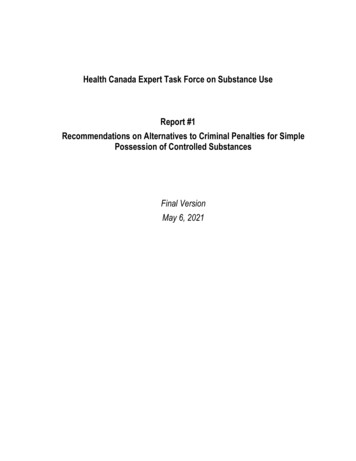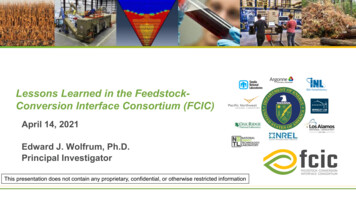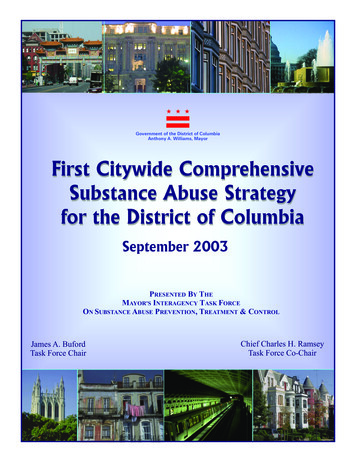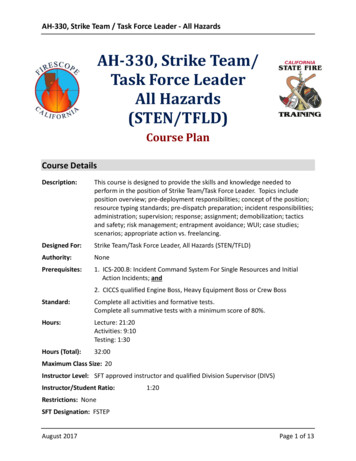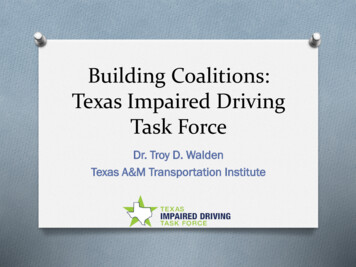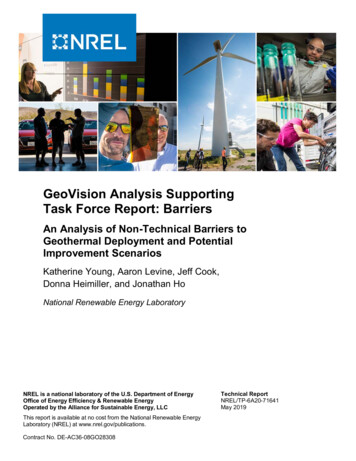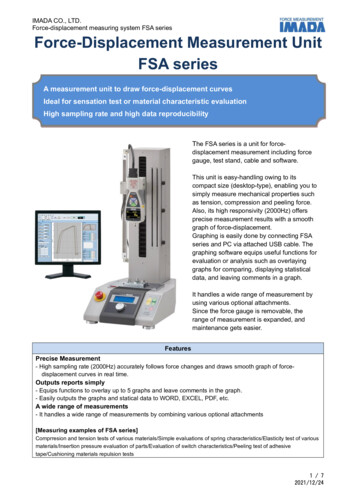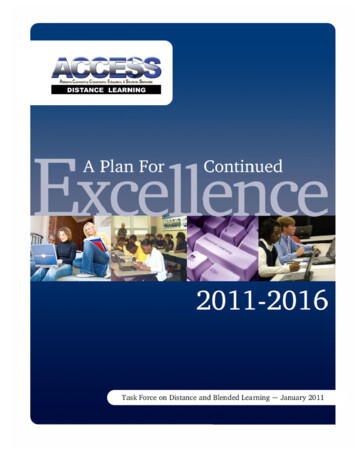
Transcription
SPONSORED BY THEALABAMA STATE BOARD OF EDUCATIONAND THEALABAMA DEPARTMENT OF EDUCATIONDr. Joseph B. MortonState Superintendent of EducationDr. Warren Craig PounceyDeputy State Superintendent of EducationAdministrative and Financial ServicesTECHNOLOGY INITIATIVESDr. Melinda Maddox, DirectorEarlene PattonLawrence (Larry) RainesDebbie CrutchfieldMisty DixonJoan GreeneJohn HalbrooksLinda JarzynieckiRamona LangstonMary (Meg) LowryRhonda OatesACCESS SUPPORT CENTER DIRECTORSBarry BarnettThe University of AlabamaDr. Anne Burgess DavidsonMadison City SchoolsReba DavisTroy UniversityNo person shall be denied employment, be excluded from participation in, be denied the benefits of,or be subjected to discrimination in any program or activity on the basis of disability, gender, race,religion, national origin, color, age or genetics. Ref: Sec. 1983, Civil Rights Act, 42 U.S.C.; Title VI andVII, Civil Rights Act of 1964; Rehabilitation Act of 1973, Sec. 504; Age Discrimination in EmploymentAct; The Americans with Disabilities Act of 1990 and The Americans with Disabilities ActAmendments Act of 2008; Equal Pay Act of 1963; Title IX of the Education Amendment of 1972; TitleII of the Genetic Information Nondiscrimination Act of 2008: Title IX Coordinator, P.O. Box 302101,Montgomery, Alabama 36130 2101 or call (334) 242 8165.ii
2011 ACCESS TASK FORCE ON DISTANCE AND BLENDED LEARNINGMargaret BlakeInstructional TechnologyCoordinatorBaldwin County SchoolsDon HulinPrincipalHoover High SchoolHoover City SchoolsRebecca S. BoddieCounselorBoaz High SchoolBoaz City SchoolsDr. Franklin KingJacksonville StateUniversityProfessor of InstructionalMediaAssociate Vice President forDistance EducationLisa Boyd, NBCTInstructional TechnologyCoordinatorJefferson County SchoolsSallie ChastainCommunity Education andE‐curriculumCoordinatorTalladega County SchoolsDr. Monica DeTureDirector of DistanceLearning and OutreachTechnologyAuburn UniversityBonnie DurhamProgram DirectorAppalachian RegionalCommissionAlabama Department ofEconomic andCommunity AffairsMichele J. KorfExecutive Director ofDistance Learning andOutreachThe University ofAlabama SystemDr. Fannie L. Major McKenzieSuperintendentDallas County SchoolsLisa MyrickACCESS TeacherSheffield High SchoolSheffield City SchoolsDr. Charles NashVice Chancellor forAcademic AffairsThe University ofAlabama SystemRandy FulmerChief Executive OfficerAlabama SupercomputerAuthorityEd NicholsAssistant SuperintendentDecatur City SchoolsMarlin HarrisACCESS TeacherPrattville High SchoolAutauga County SchoolsAllan A. PizzatoExecutive Director ofAlabama PublicTelevisioniiiRebecca PowAssociate Dean, College ofContinuing StudiesThe University ofAlabamaJ. Ricky SizemorePrincipalMarion County High SchoolMarion County SchoolsRonald SnellPrincipalNorthview High SchoolDothan City SchoolsDr. Lance E. TatumDean of EducationTroy UniversityJackie PoseyRepresentativeSave Alabama’s SmallSchoolsAlabama AriseMargie TreadwellCounselorDaleville High SchoolDaleville City SchoolsLaura WardCounselorChilton County High SchoolChilton County SchoolsTommy WhittenDistrict TechnologyCoordinatorMadison County Schools
TABLE OF CONTENTSExecutive Summary .1Statement of Intent .3Vision .3Mission .3Goal.3Background and Status .3Objectives for 2011 2016 .9Offerings .Availability and Use.Models of Instruction .Instructional Support .Student Support .Collaboration .Visibility .State Oversight .Sustainability .999101011111212Budget .13Conclusion .13Bibliography .14iv
ACCESS: A DISTANCE AND BLENDED LEARNING MODEL FOR ALABAMA2011 2016JANUARY 2011EXECUTIVE SUMMARYThe Alabama ACCESS (Alabama Connecting Classrooms, Educators, and StudentsStatewide) Distance Learning Initiative was launched November 1, 2004, with initialfunding of 10.3 million starting October 1, 2005. The distance and blended learninginitiative was the culmination of research and planning by the Task Force on DistanceLearning. In Year One, the central vision of the Task Force was to provide equal access tohigh‐quality instruction to improve student achievement through distance learningopportunities. In Year Two through Year Five, the vision became reality. The ACCESSDistance Learning Initiative has become a cornerstone in providing equitable education toALL Alabama public school students in a cost‐effective model regardless of their zip codes.This initiative is providing opportunities for students at their local community schools thatwould have otherwise not been possible. It has surpassed all original goals by developing ablended learning model providing resources, connectivity, and professional development,thus involving not only distance learning, but various blended learning models of delivery.This has supported the growth and excellence of Alabama teachers, expanded their reachacross the state, given our schools the resources to develop and offer new communities oflearning, and given our students the advantage of being prepared for college and careers.Even more opportunities are being planned for 2011‐2016. As education is beingredesigned across our nation, ACCESS is positioned to enable all Alabama public highschools to move to a more accessible blended learning course delivery model, providingopportunities for every student so that all Alabama’s high school graduates are college‐ andcareer‐ready.The objectives and strategies for 2011‐2016 have the potential to transform teaching andlearning by providing high‐quality learning opportunities for all students in Alabama.Providing flexible time, pace, and place instruction for all Alabama students will enableeducators to customize the educational environment so every student learns in his or herown style and at his or her own pace. The objectives are divided into nine sections:Offerings, Availability and Use, Models of Instruction, Instructional Support, StudentSupport, Collaboration, Visibility, State Oversight, and Sustainability. The nine objectivesare as follows:Page 1
Objective 1: Provide students with additional courses and electivesneeded to meet individual educational goals and to provide a fullyrounded curriculum, including 21st Century skills accessible to allpublic high schools in Alabama.Objective 2: Expand the availability and use of ACCESS Distance andBlended Learning.Objective 3: Refine and expand the blended model of instruction toevery high school with attention to the following: individual andinstitutional needs; flexible time, pace, and place accommodation;budget efficiencies; standards; and leveraging existing resourcesthroughout the state.Objective 4: Use ACCESS resources, including online professionaldevelopment and best practices, to support and evaluate teachers andfacilitators and to prepare them for effective, efficient facilitation oflearning.Objective 5: Provide a continuum of mentoring for students by takingadvantage of the full range of stakeholders.Objective 6: Establish collaborative relationships with two and four year institutions, industry and other community entities to facilitateand enhance college and career preparatory coursework.Objective 7: Expand awareness, understanding, and appreciation of theACCESS program and structure among all stakeholders.Objective 8: Provide administrative oversight, management, andsupport through the Alabama Department of Education and SupportCenters.Objective 9: Refine a sustainability and long term funding plan formaintenance and growth in the number of students served.The ACCESS initiative has become a cornerstone for our efforts in Alabama to provideequity toward a quality education and reverse statistics citing Alabama among the lowest‐performing states for high school and college graduates. In just six years ACCESS hasreached out to serve all high schools within the state, and is now widely relied upon toprovide key expanded offerings to students, teachers, and schools. Yet there is even greaterpromise for return on investment. Through existing infrastructure, services, and content,ACCESS is positioned to enable efficiencies within the state while at the same timedramatically broaden quality education opportunities. Proven success coupled withefficiency has never been more critical, and ACCESS Distance and Blended Learningrepresents enormous potential to leverage support as it contributes to the futureeducational agenda.Page 2
STATEMENT OF INTENTThe intent of this ACCESS (Alabama Connecting Classrooms, Educators, and StudentsStatewide) Plan 2011‐2016 is to outline the objectives and strategies necessary tomaintain, support, and further advance the vision of this highly successful and nationallyrecognized instructional program. These objectives are designed to enhance the ACCESSDistance and Blended Learning model and leverage its infrastructure and resources forfuture growth.VISIONThe state of Alabama will provide equal access to high‐quality instruction to improvestudent achievement through distance and blended learning.MISSIONThe mission of the Alabama ACCESS Distance and Blended Learning model is to provide aninfrastructure that delivers equitable, quality learning opportunities for all high schoolstudents.GOALThe goal of the Alabama ACCESS Distance and Blended Learning model is to provide equitythrough additional high‐quality course offerings for all Alabama public high schoolstudents.BACKGROUND AND STATUSACCESS Distance and Blended Learning delivers quality instruction and coursework toAlabama students by blending Web‐based and interactive videoconferencing coursestaught by Alabama teachers; provides technical infrastructure; provides regional supportcenters to hire, train, and support e‐teachers; and offers statewide coordination.ACCESS is an innovative program that has redesigned the model for distance learning,tailoring online and interactive videoconferencing services to the needs of schools andindividual students through a blended delivery method. ACCESS is the first statewideinitiative that has focused on bringing truly equitable instructional opportunities to allAlabama public high school students, regardless of where they attend school.This program, under the supervision of the Alabama Department of Education, has strongpartnerships with the Governor’s Office, the Alabama Supercomputer Authority, and localschool districts that have been key to its success. In essence, ACCESS is changing the face ofeducation in Alabama, making a positive difference in teachers, schools, and ultimatelyeconomic development for the state.Page 3
In six short years, Alabama’s ACCESS Distance Learning program has grown from a visionto the reality of providing every high school student an opportunity to take a wide range ofcourses. A Task Force was convened in the fall of 2004 to develop a plan that waspresented to the legislature in the spring of 2005. ACCESS Distance Learning was funded at 10.3 million for FY06 and is currently funded for FY11 at 19 million.In 2003, Alabama administered only 99 Advanced Placement exams per 1,000 juniors andseniors, ranking 14th out of 16 southern states. Alabama had a high need for a remediationand supplemental resources plan to increase the high school graduation rate. Alabama alsohad difficulty attracting and retaining highly qualified teachers (particularly in rural,impoverished areas) and especially in the areas of foreign languages, Advanced Placement,and other electives. With the implementation of ACCESS and other state initiatives, strideshave been made in each of these areas. Thus, in 2007, the Average Freshman GraduationRate was 67%, up from 62% in 2002. Since 2004, the number of Advanced Placement testtakers in Alabama public schools has almost doubled. The number of African American testtakers has more than quadrupled, and the number of qualifying exam scores has more thandoubled. Five times more low‐income students are taking Advanced Placement exams andthree times more are scoring 3 or higher.Funds have been awarded through this program to the schools so that all Alabama publichigh schools now have a 21st Century distance and blended learning lab including tabletcomputers, videoconferencing equipment, interactive whiteboards, and other technologies(completed in the fall of 2009). Broadband connectivity (minimum of 20Mbps and recentlyupgraded to 50Mbps based on demand) has been funded by the program and installed inevery public school system. Virtual field trips have been organized and delivered byexperts such as NASA and Antarctica scientists, foreign diplomats, FBI Special Agents, andothers.Extensive outside evaluation is conducted annually by the International Society forTechnology in Education (ISTE), and changes are made in response to this feedback. The2009‐2010 ISTE report cited the positive impact of ACCESS.: (1) Increases GraduationRate; (2) Broadens Students’ Horizons on Higher Education; (3) Prepares Students forCollege and the World of Work; (4) Enhances Students’ Attitudes Toward Learning; and (5)Gives Students a “Window on the World.” One principal observed, “We decreased ourdropout rate by 16% in five years. We went from last to first in test scores in several areas,thanks to ACCESS.” Another principal said, “ACCESS brings the world of education to thelocal level.” One principal summarizes, “ACCESS is taking all of us (in Alabama) into the21st Century.” The report states, “though the primary goal of the ACCESS Distance andBlended Learning Initiative is increased access to high‐quality educational opportunitiesfor all Alabama students, program personnel continue to hear anecdotal observations thatthese opportunities are having pervasive impact on educational reform efforts throughoutthe state.”Page 4
The program is currently offering 115 unique courses, including 13 Advanced Placementcourses. In FY2010 alone, ACCESS provided 29,415 student enrollments in courses neededby students to meet graduation requirements and 11,746 additional enrollments in non‐credit remediation modules for the Alabama High School Graduation Exam and CareerForward. In the area of foreign languages, ACCESS has delivered more than 9,981enrollments in five different foreign languages including French, German, Latin, Spanish,and Mandarin Chinese. Over 659 teacher units have delivered courses for FY2010. Now,students can be taught by certified, highly qualified Alabama teachers, regardless of wherethey live. A breakdown by year is as follows:YearFY06FY07FY08FY09FY10Grants toPilotSchools4426100190CreditNon CreditEnrollments 977115107115Rigorous, high‐quality, Web‐based, and Interactive Videoconferencing (VCI) courses arealigned with Alabama standards. These courses include over 65 Web‐based courses withadditional courses under development, as well as various VCI courses as determined by theschools offering the courses. Dual enrollment/dual credit courses are being delivered viathe ACCESS infrastructure. In addition, five remediation modules for the Alabama HighSchool Graduation Exam (AHSGE) and Advanced Placement Exam Reviews in ten contentareas are offered for all students throughout the state. Course development and upgradeare continuous processes that include a team of course designers and content experts. Allcourses undergo an alignment and approval process by additional content expertsincluding experienced ACCESS teachers.Instructional and technical support is provided by three regional support centers: TroyUniversity ACCESS Support Center; The University of Alabama ACCESS Support Center; andMadison City Schools ACCESS Support Center, as well as the Alabama Department ofEducation staff. Statewide technical infrastructure has been established that includes 21stCentury ACCESS classrooms in all Alabama public high schools through awarding oftechnology grants. The three regional support centers provide a level of support unique tothe ACCESS program. Located at Troy University, The University of Alabama, and MadisonCity Schools, the ACCESS Support Centers train, hire, mentor, and supervise ACCESSteachers. The support centers are a vital link in program management in that they providecontinuous assistance, communication, and training to counselors, principals, teachers,facilitators, and students in the learning management system, the registration portal,policies, and procedures. This regional model of support has enhanced the rapid growthand implementation of the ACCESS program.Page 5
Network connectivity serving the ACCESS Distance Learning program is provided by theAlabama Supercomputer Authority (ASA) through its statewide education network, theAlabama Research and Education Network (AREN). ASA provides the level of broadbandconnectivity required by ACCESS schools to successfully participate in VCI and Web‐basedcourses. Initially, ASA provided 10Mbps of broadband connectivity to all school systems.Subsequently, broadband connectivity upgrades have been installed, first to 20Mbps andlater to 50Mbps for school systems based on usage demands as monitored by ASA’sNetwork Operations Center. Broadband connectivity is provided to ACCESS schools asneeded depending on the school system’s connectivity infrastructure choice. In addition,ASA provides broadband connectivity to the three ACCESS Regional Support Centers and tothe Alabama Department of Education to enable effective program administration andtraining. Alabama’s colleges and universities are also served statewide through the ARENinfrastructure. A key benefit of the AREN infrastructure is the ability to deliver all ACCESSIP traffic over a managed network with network “quality of service” guarantees. Thismeans that VCI traffic that is sensitive to “on time delivery” is guaranteed to be ofmaximum quality through network engineering and management services provided byASA. Additionally, ASA makes available the services of a VCI bridge to all ACCESS schoolsfor VCI sessions requiring a number of connections that exceed the capacity of the school’slocal VCI equipment. This has proven to be especially important for virtual field trips suchas the UAB Antarctica event, which needed to connect 20 schools. AREN also provides itsclient base access to national research networks such as Internet2 (I2) and NationalLambdaRail (NLR).ACCESS onsite and online professional development for teachers, facilitators, counselors,and principals follows the guidelines set forth by the State Virtual School Supportcomponent of SREB’s and iNACOL’s Guidelines for Professional Development of OnlineTeachers. Learning activities are currently implemented that support the standards andtheir associated indicators in SREB’s and iNACOL’s Standards for Quality Online Teaching.We have developed a four‐step plan that consists of: (1) three‐day face‐to‐face pre‐servicetraining with experienced teachers who desire to become ACCESS teachers; (2) peerLeader‐to‐Protégé training during the first and second terms of novice teacher courseassignment; (3) an ongoing Professional Development Plan, with training provided by theACCESS SDE staff that requires teachers to complete six hours the first year and two hourseach year after of online ongoing distance and blended learning training covering 20–25topics; and (4) “anytime training” offered through Connecting ACCESS Staff and Teachers,the Learning Management System course, providing tutorials, discussion board, news andannouncements, etc., to make available immediate instruction, help, and resources. To meetthe plan requirement for the calendar year 2010, the following professional developmentactivity hours have been offered: (1) collectively, the support centers offered 558 hours offace‐to‐face training to ACCESS stakeholders including teachers, facilitators, principals, andcounselors from school districts across the state; (2) support centers also offered 12 hoursPage 6
of online professional development to the same stakeholders; and (3) in 2010, the ACCESSstaff at the Alabama Department of Education offered 250 hours of online training and 11hours of conference training at the Alabama Educational Technology Conference in June.A new student registration system has recently been implemented that is integrated withthe state student information system and the ACCESS learning management system. TheState Department staff and three support centers offer professional development andextensive helpdesk support to schools and teachers in the registration and grade‐awardingprocess. During the past five years, policy manuals have been developed to support theneeds of the students, teachers, facilitators, and administrators. Each year these policies arereviewed to allow flexibility at the schools to meet the needs of each student whileensuring quality.From the beginning in 2005, ACCESS has developed a blended model of instructionaldelivery using Web‐based course content, Web conferencing software, and VCI equipment.Currently, new models of blended instruction are being adopted as Alabama teachers areusing the ACCESS online resources and content in their face‐to‐face classes. Alabama’s firststatewide Distance Learning Week was initiated in 2010 with a variety of virtual field trips.The blended approach to instructional delivery is now being implemented in differentmodels in Alabama, such as the blended model of delivery being piloted by Hoover HighSchool. Currently, seniors at Hoover High School have the option of taking 12th GradeEnglish and/or 12th Grade Economics and U.S. Government through a blended class wherethey meet face to face with their teacher once per week and complete assignments andother discussions online. Validity for summative and performance assessments ismaintained. This model lessens the physical demands on the high school building in termsof classrooms and space, and strict student eligibility guidelines are adhered to. The pilotprepares students for online college learning and creates time for students to enroll incollege coursework and/or work part‐time while enrolled. The pilot phase is limited to 120students; however, student, faculty, and community interest is extremely high withanticipation of program expansion.Despite its relatively short existence, ACCESS has already been identified as the thirdlargest state virtual school in the country in the 2010 Keeping Pace with K 12 OnlineLearning. The program has received national and international attention through a numberof articles in major professional journals that have referred to it as a catalyst for progress ineducation and a trailblazer in distance learning. The Economist said, "ACCESS is leveling theplaying field.” Film crews and reporters from national FoxNews and CNN have visitedAlabama to interview and film ACCESS leaders, teachers, and students. Both networks haveaired segments featuring the positive work Alabama is doing in providing equitableeducation to all students through distance learning. ACCESS sites have also been toured byrepresentatives from other countries who have learned of the program’s success. ArticlesPage 7
have been written in eSchool News, T. H. E. Journal, Converge, Principal Leadership, Internetand Higher Education, and numerous newspapers. Books such as ISTE’s TechnologyFacilitation and Leadership Standards and Evaluating Online Learning Challenges andStrategies for Success have featured sections on ACCESS Distance Learning. A detailedbibliography is included.Page 8
OBJECTIVES FOR 2011 2016OFFERINGSObjective 1: Provide students with additional courses and electives needed to meetindividual educational goals and to provide a fully rounded curriculum, including21st Century skills accessible to all public high schools in Alabama. Provide access to additional course offerings including, but not limited to,advanced diploma, dual credit, Advanced Placement, and InternationalBaccalaureate courses.Provide opportunities at earlier grade levels to prepare students to takeadvanced academic courses.Provide access to credit recovery and remediation courses.Provide access to additional supplemental resources including virtual fieldtrip opportunities.Provide a comprehensive learning objects repository and create an incentiveprogram for the development and sharing of model courses and modules.AVAILABILITY AND USEObjective 2: Expand the availability and use of ACCESS Distance and BlendedLearning. Develop understanding of the essential nature of the ACCESS program by allschool instructional leaders.Expand the extent of use of ACCESS in every public high school with a goal ofgiving every high school student the opportunity to participate in an ACCESSlearning experience.Develop processes for non‐traditional students to enroll and participate inACCESS courses through their local public school.Develop procedures to implement annual VCI scheduling in early spring.Develop additional electives including fine arts, career technical, computing,and technology.Make multimedia and technology tools to enhance instruction available to allteachers.Provide ACCESS equipment grants to career tech centers as funding permits.Develop experiences for middle school students through adevelopmental/incremental approach that will prepare them for fullyindependent online/distance/blended learning courses as funding permits.MODELS OF INSTRUCTIONObjective 3: Refine and expand the blended model of instruction to every highschool with attention to the following: individual and institutional needs; flexibletime, pace, and place accommodation; budget efficiencies; standards; and leveragingexisting resources throughout the state.Page 9
Develop ways and provide support for ACCESS teachers to use coursecontent in their face‐to‐face (F2F) classes using a blended course model.Develop ways and provide support for schools to offer ACCESS courses withflexible time, pace, and place instruction.Develop ways and provide support for all high school teachers to incorporateACCESS technologies and resources in F2F classroom teaching strategiesusing a blended course model.Develop and refine course delivery to follow Alabama and SREB standardsfor distance and blended learning pedagogy addressing the following:student learning styles, student‐centered instruction, outcomes‐basedlearning, evaluation/assessment methods, and the use of rich media.Develop strategies strengthening student‐teacher relationships including anincentive program to encourage periodic teacher visits, increased liveinteraction with online students, and other F2F encounters during onlineexperiences.Support success of all students by establishing rewards for self‐discipline inkeeping pace, meeting deadlines, and mastering course content.Reflect emerging technologies while utilizing existing resources to the bestadvantage.INSTRUCTIONAL SUPPORTObjective 4: Use ACCESS resources, including online professional development andbest practices, to support and evaluate teachers and facilitators and to prepare themfor effective, efficient facilitation of learning. Develop criteria and implement a system to evaluate and showcase teachereffectiveness.Measure teacher and facilitator effectiveness using performance metricsmeasuring student participation, grades, and course completion rates.Document best practices on all levels, sharing examples through a repositoryand using them for training purposes.Record examples of exemplary teaching to document best practices forfuture professional development use and parent education. Curate thisrepository.Develop standardized criteria for
Statewide) Distance Learning Initiative was launched November 1, 2004, with initial funding of 10.3 million starting October 1, 2005. The distance and blended learning initiative was the culmination of research and planning by the Task Force on Distance Learning.

